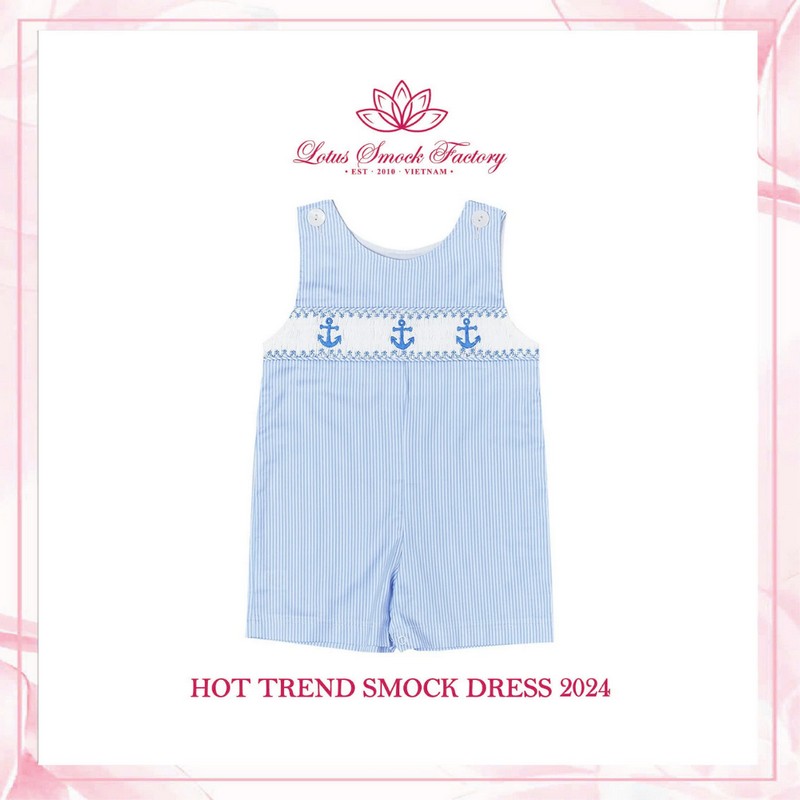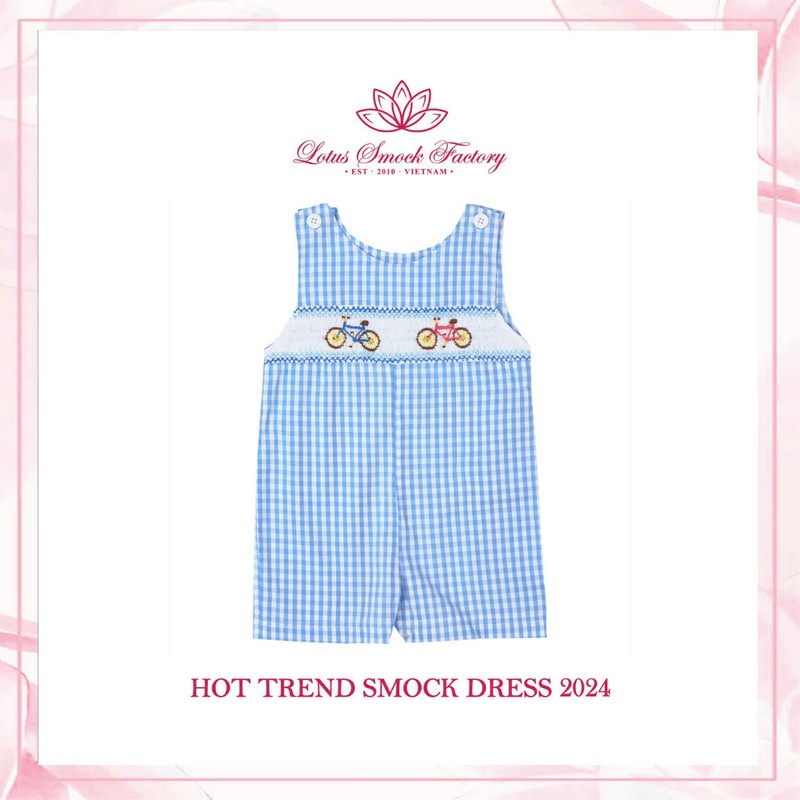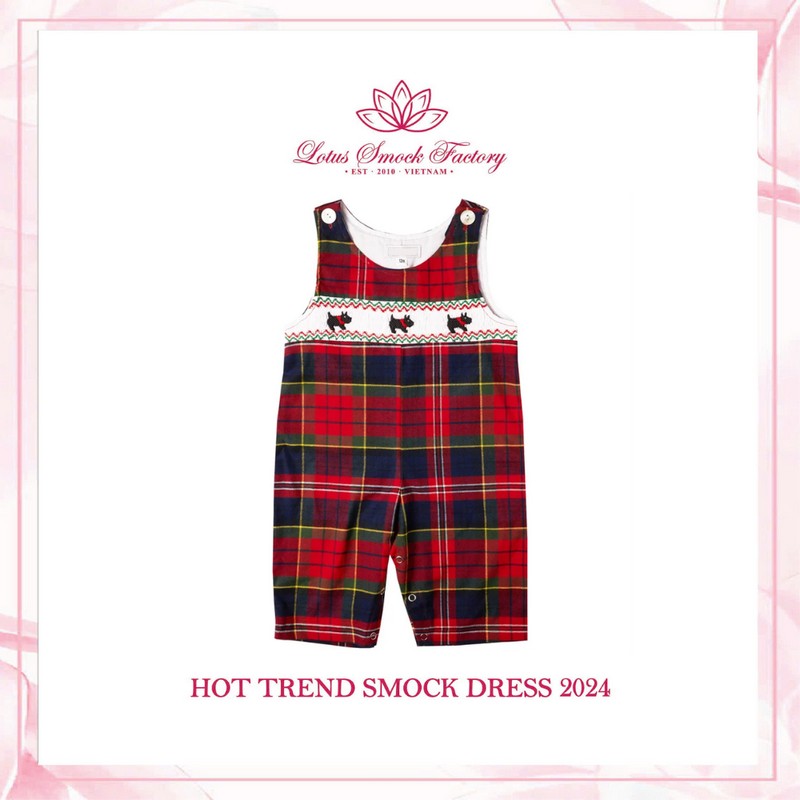Lotus Smock
13 posts
Nov 02, 2025
12:55 AM

|
In the charming world of children’s fashion, few garments combine heritage, craftsmanship, and timeless beauty quite like the smocked longall and shortall. These classic outfits have long been symbols of elegance and comfort, often passed down from one generation to the next. What makes them truly special is the intricate hand embroidery that adorns them—an art form that transforms a simple piece of fabric into a treasured work of beauty. In the field of embroidery, smocked longalls and shortalls stand as masterpieces of patience, precision, and creativity.

See Article Details At: Smocked Longall/Shortall
The Historical Roots of Smocking
The art of smocking dates back to medieval England, when it began as a practical sewing technique rather than a decorative one. Before the invention of elastic, workers’ garments were stitched with small pleats that allowed for flexibility and comfort during physical labor. This gathering of fabric, called smocking, was secured with small stitches to hold the pleats in place. Over time, seamstresses and embroiderers began adding decorative stitching to the pleats, giving rise to an entirely new art form.
See More At: Little Outfit, Big Smiles

By the 18th and 19th centuries, smocking had evolved into an elegant decorative technique used in women’s and children’s clothing. The smocked longall and shortall, in particular, became staples in children’s wardrobes. Designed with a focus on both functionality and beauty, these garments showcased the perfect marriage of comfort and craftsmanship. Today, smocked clothing remains an enduring symbol of classic embroidery and timeless design.
View At: Smocked Longall and Shortall: A Classic Showcase of Embroidery Craftsmanship

Understanding Smocking as an Embroidery Technique
At its heart, smocking is an embroidery method that gathers fabric into small, uniform pleats and embellishes them with hand stitches. These stitches can be purely functional, holding the pleats in place, or decorative, forming intricate patterns across the fabric. The embroidery threads—usually made from cotton or silk—add color, texture, and dimension to the garment, creating a distinctive aesthetic that defines traditional smocked clothing.
View At: Smocked Longall and Shortall: The Perfect Blend of Tradition and Embroidery Art
Smocked longalls and shortalls often feature hand-stitched designs on the chest panel, known as the smocked yoke. Artisans use techniques like the cable stitch, wave stitch, and honeycomb stitch to form geometric patterns or picture motifs. Popular designs include sailboats, toy trains, bunnies, flowers, or seasonal themes such as pumpkins and holly leaves. Each motif tells a story, reflecting the creativity and personality of the embroiderer. Because every piece is hand-stitched, no two smocked garments are exactly alike, giving each one a unique character and charm.
While machine-smocked garments exist today, hand embroidery continues to be prized for its authenticity, craftsmanship, and emotional value. Every hand-stitched smocked longall or shortall carries a human touch—a connection between the maker and the wearer that cannot be replicated by mass production.
Design, Fabric, and Craftsmanship
The beauty of a smocked longall or shortall lies in its simplicity and fine details. These garments are traditionally made from natural, breathable fabrics such as cotton, linen, or batiste. For more formal occasions, materials like velvet, silk, or corduroy may be used. The choice of fabric plays an important role in how well the smocking pleats hold their shape and how the embroidery appears against the texture of the material.
A longall is a full-length one-piece outfit with long legs, making it ideal for cooler weather or dressier occasions. A shortall, on the other hand, has short legs and is perfect for warmer climates or casual events. Both styles feature a smocked chest panel as the focal point, often framed with a rounded collar, piping, or buttoned straps. The balance between structure and softness in the design makes these outfits both stylish and comfortable for children.
The Emotional and Cultural Value of Smocked Clothing
Smocked longalls and shortalls hold deep sentimental value, often marking special milestones in a child’s life. They are popular choices for birthdays, christenings, holidays, and family portraits because of their timeless and classic look. For many families, these garments become keepsakes passed down through generations, carrying memories of childhood and family traditions.
In the field of embroidery, smocking represents more than just a decorative technique—it symbolizes continuity and connection. The meticulous handwork reflects an appreciation for slow fashion, where every stitch tells a story of patience, craftsmanship, and love. Owning or gifting a hand-smocked outfit is a way of honoring this tradition and celebrating the artistry that goes into every handmade piece.
Each smocked longall or shortall carries with it the spirit of the artisan who made it, connecting modern wearers to centuries of embroidery heritage. This combination of personal sentiment and cultural history gives smocked garments their enduring appeal.
Modern Trends and the Return of Handmade Embroidery
While the smocked longall and shortall remain deeply rooted in tradition, modern designers continue to reinterpret them for today’s fashion. Some incorporate contemporary colors, bold patterns, and minimalistic details, while others stay true to classic pastel shades and nostalgic embroidery motifs. Regardless of the style, the essence of hand-smocked embroidery remains unchanged—celebrating craftsmanship and quality over speed and mass production.
Conclusion
The smocked longall and shortall are more than just children’s outfits—they are enduring symbols of embroidery’s artistry and history. Each pleat and stitch speaks of patience, creativity, and dedication, connecting generations through the art of handmade design. Whether cherished as heirlooms or worn for special moments, these garments remind us that true beauty lies in craftsmanship, not in trends. In a world that moves fast, smocked clothing continues to stand for everything embroidery represents—timelessness, tradition, and the touch of a human hand.
At Lotus Smock, we redefine wholesale smocked clothing with a blend of tradition and innovation. Known for our smocked dresses, kidswear, and customized designs, Lotus Smock uses premium fabrics and skilled Vietnamese artisanship to create clothing that delights worldwide customers. #, #, #, #, #
|